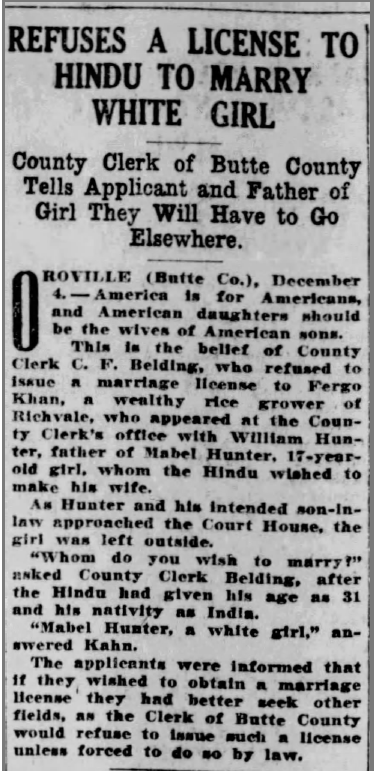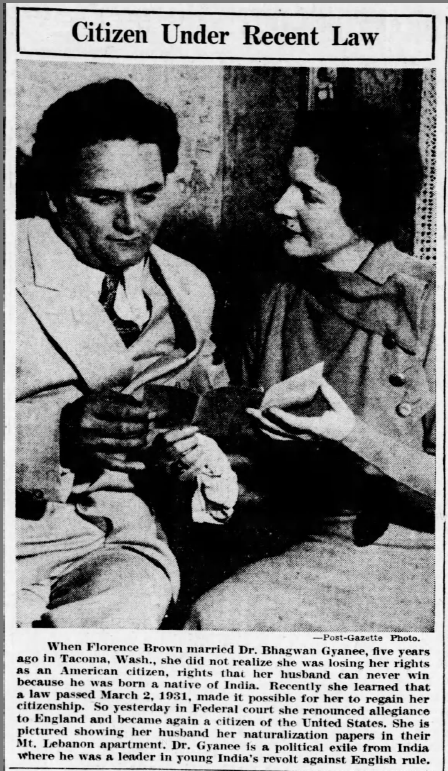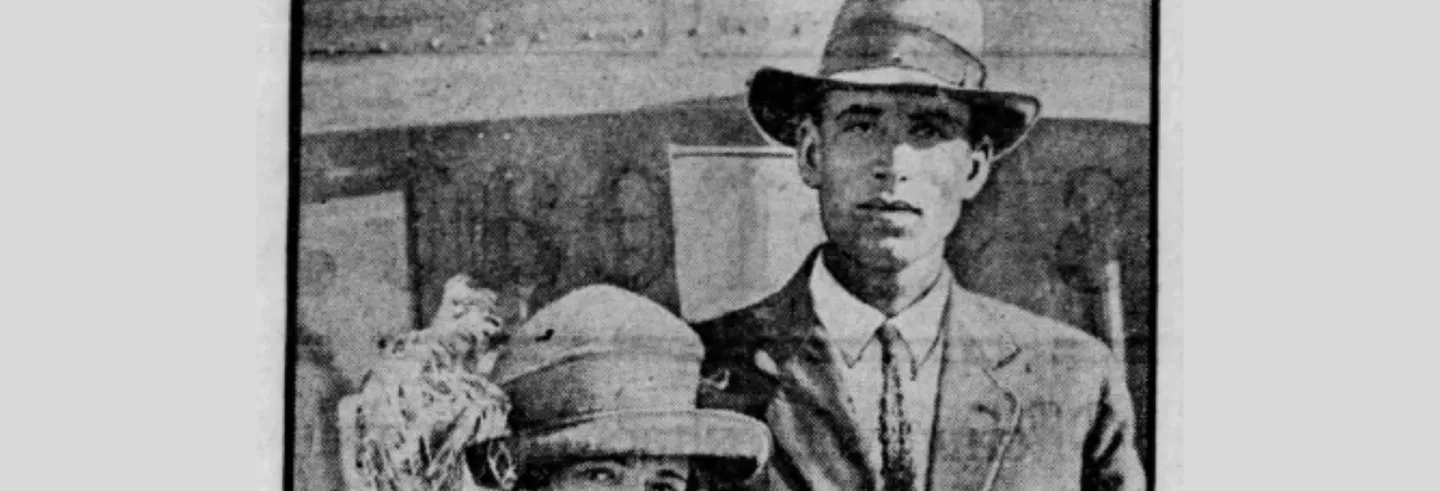In 1919, the county clerk in northern California’s Butte County refused to issue Fergo Khan, a wealthy ‘Hindu’ rice farmer, a licence to marry Mabel Hunter, a ‘white’ girl, because “American daughters should be the wives of American sons, and that America is for Americans” (Sacramento Bee, 4 December 1919). In various ways, the decision reflected the particularly contentious clime that prevailed then against interracial marriages.
Two years before, in 1917, the Immigration Act or the ‘Barred Zone Act’ had decisively restricted entry to the United States of those who claimed origin from a wide swathe of territories stretching across Asia. For the ‘Hindus’ — a misnomer then widely used for all South Asians — already resident in the US, this only added to the uncertainty. In recent years, several of them had been granted naturalisation on grounds that they were ‘Caucasian,’ and hence, ‘free and white’ as per requirements of the US Naturalization Act of 1790. But challenges to such decisions had emerged. This ‘ambiguity’ gave considerable discretionary power to the county clerk, the district official who managed and maintained public records and issued the necessary licences.
In 1921, the California newspaper, Sacramento Bee, wrote of the consternation that followed the marriage of a Hindu, Harry Sahato, with a white girl, Grace Ida Bahrs, in Martinez in Contra Costa county in the San Francisco Bay region. As the county clerk declared, Hindus were, as per recent legal rulings, Caucasians and there was nothing to prevent the marriage. According to the California law relating to marriage and ‘miscegenation’, interracial marriages in the state were only banned between ‘negroes, mulattos, and Mongolians’ (terms now not in use and justifiably discredited).
The portmanteau word, ‘miscegenation’, drew from the Latin terms, ‘miscere’ (mix) and ‘genus’ (race or kind).
Some months later, in 1923 in Yuba City, northern California, the local justice of the peace solemnized the marriage, between 17-year-old Julia Fernandez, described as a “pretty looking Spaniard”, and the considerably older ‘Hindu’, Gamon Khan. This marriage over the next few years, however, would produce considerable drama.
In 1929, Julia left her husband, abandoning her marriage of six years. Her husband accused her of having an affair with a San Francisco-based stockbroker. In turn, Julia Fernandez sought various ways to have her marriage annulled. In 1929, she accused him of bigamy; that Gamon Khan had already been married in India and had hidden this from her; and then again in 1932, appealing to the court that the marriage was illegal because Gamon Khan was not Caucasian.

The judge at Plumas County who heard this case clarified the law with a finality based on California’s miscegenation law of 1850, amended in 1880, and 1905: Gamon Khan was a Caucasian. This made him white and the marriage legal, for Mexicans too were classified as whites as per the state’s laws.
Miscegenation: The beginnings
The term ‘miscegenation’ was coined in 1863, just before the 1864 elections, held towards the end of the American Civil War (1861-1865), which pitted then President Abraham Lincoln of the National Union Party (made of Republicans and Democrats supportive of the Civil War) against the Democrat candidate, George B. McClellan. Two New York City journalists drew up a pamphlet evoking the virtues of ‘racial mixing’. The portmanteau word, ‘miscegenation’, drew from the Latin terms, ‘miscere’ (mix) and ‘genus’ (race or kind). The pamphlet was a ‘literary prank’, intended to sound the alarm about racial equality. From then onwards, ‘anti-miscegenation’ became a widely used phrase denoting policies and laws enacted against interracial marriages and unions.
[A]s far as South Asians, i.e., ‘Hindus', were concerned, anti-miscegenation was an issue full of intriguing contradictions...
In the 17th century, interracial marriage laws, largely understood as forbidding unions between whites and blacks in the US, had been in place in several American states. Over the next century, such laws in some states had been repealed. However, after 1865 when slavery was abolished by an act of Congress, and after the 14th Amendment that ensured for blacks ‘equal protection under law’ was passed in 1868, several states found reasons to amend, and resuscitate their anti-miscegenation laws.
Anti-miscegenation laws added to the segregation and other ‘Jim Crow’ laws that vast parts of the country, chiefly in south and central US, witnessed in the post-Civil War era. ‘Jim Crow’ laws, named after a minstrel show, were a catch-all term denoting local and state laws that denied blacks rights such as those related to voting, civic life, schooling, as well as employment.
Early anti-miscegenation laws
About 30 American states imposed varying degrees of penalties against interracial marriages, the intent in all was to preserve ‘racial purity’, and the superiority of the white race. In their laws, states variously defined in ‘exact’ ways how marriage between whites and blacks was illegal, the categories of non-whites such laws ruled against, set up fines—and for some states, terms of imprisonment–and refused recognition to children born of such marriages.
Florida, for example, barred marriage of whites with those of “1/8th African or Negro blood”, ruled offspring of such marriages illegitimate and imposed penalties including a prison term of as much as 10 years. Alabama’s law forbade marriage with those with ‘one drop of Negro blood,’ imposing prison terms ranging from two to seven years for violations.
Two important court decisions, moreover, upheld such laws. The Supreme Court in Pace vs the State of Alabama (1884) ruled that despite the equality guaranteed (equal protection by law) by the 14th Amendment, laws like Alabama’s anti-miscegenation laws ensured that both races were punished equally by the laws in place. Laws like Alabama’s anti-miscegenation law applied to races in equal measure. In the more infamous Plessy vs Ferguson case, the Court ruled that racial segregation laws did not violate the US Constitution as long as the “facilities for each race were equal in quality”. This ruling sanctified the "separate but equal” doctrine that remained acceptable till the 1954 Brown vs Board of Education ruling and 1960s legislative enactments such as the Civil Rights Act and the Voting Rights Act.
Asians and anti-miscegenation
Beginning from the 1860s onwards, with the rising immigration of first the Chinese, and then the Japanese, states in the west and south amended their laws to bar marriages with ‘aliens’ from Asia. Such laws were first directed against the Chinese, whose numbers grew manifold between 1860 and 1900: to 118,746 from 34,933, as Deenesh Sohoni (2007) details.
Chinese immigration was restricted first with the Anti-Exclusion act in 1882, while emigration from Japan to the US was limited by the ‘Gentleman’s Agreement’ of 1907. The widespread anti-immigration sentiment of the times, especially in the western states led to other exclusionary measures: denial of naturalization and the right to marry, imposition of alien land laws, and segregation in schools. As the philosopher Hannah Arendt wrote in 1958, the anti-miscegenation laws constituted an injustice “even deeper than the racial segregation of public schools”. “The free choice of a spouse,” Arendt argued, was “an elementary human right.”
The state of Nevada in 1861 became the first state to pass a law specifically barring the Chinese in its anti-miscegenation laws, when it restricted marriages between whites and “colored, including blacks, native Americans and Chinese”. Arizona in 1865 first included ‘Mongolians’ (a word seen to be ‘wider’ in scope) in its anti-miscegenation law: “All marriages of white persons with negroes, mulattoes, Indians (native Americans), or Mongolians are declared illegal and void.” The term ‘Mongolian’ soon became more acceptable then.
As other Asians arrived from the 1890s onward, such as Koreans, Filipinos, and then Indians, (5,008 Koreans, 5,424 Asian Indians or ‘Hindus’, and 2,767 Filipinos or ‘Malays’ in 1910, as Sohoni details) such discriminatory measures were applied to them as well.
[B]etween 1909 and 1923, there were several notable cases involving South Asians where the argument was made that as ‘high-caste Aryans’ they were Caucasians, and, hence, free and white...

In all, 15 states (included in the 30 that already had anti-miscegenation laws in place) amended laws to restrict the marriage of whites with Chinese or Mongolians (that came to include the Japanese, as court rulings such as the Saito vs the US of 1894 established). Then, following increasing migration from the Philippines, anti-miscegenation laws in some states—California, Arizona, Nevada, Utah, South Dakota, Wyoming and curiously, Maryland—were amended to include Malays.
The word gained currency thanks to the dubious racial and anthropological theories than popular. It was first biologist Carolus Linnaeus, who, in the mid-1700s, classified humans into four varieties based on skin colour: red, yellow, white, and black. In 1781, Johann Friedrich Blumenbach, whose theory was cited in some early naturalization rulings in the US, expanded on the Linnaean system by classifying humans into five categories: Caucasian, Mongolian, Negro, Malay and American (Volpp, 2000).
‘Hindus’ and anti-miscegenation
However, as far as South Asians, were concerned, anti-miscegenation was an issue full of intriguing contradictions. 'Hindus' became a restrictive category in Arizona’s anti-miscegenation laws (1931), and in the eastern states of Virginia and Georgia (1927 and 1924). In other states, classifying the ‘Hindus’ placed a lot of discretionary power in the hands of the county clerks. For example, in California, sometimes it all depended on whether the ‘Hindu’ applying for a marriage licence knew English, looked presentable, and wore a ‘hat, instead of a turban’ — as Sikhs, who made up most migrants from India, did (The Sacramento Star, 25 May 1916).
Legal restrictions on marriage were not enforced with as much rigour when it came to marriages between blacks and people of colour.
Between 1909 and 1923, there were several notable cases where South Asians argued that, as ‘high-caste Aryans’, they were Caucasians and, hence, free and white, meeting the naturalization criteria of US laws. This also made them ‘white’ as far as miscegenation laws were concerned.
It was the decisive 1923 US Supreme Court ruling in the case Bhagat Singh Thind case that South Asians were not 'free and white' that opened up an assortment of other issues. For instance, in California and Arizona, states which had seen more ‘Hindu’ immigration in recent years, they were now subject to the land laws that denied ownership of agricultural and other property to “aliens ineligible for citizenship”. Arizona’s amended anti-miscegenation laws of 1931 related directly to its 1923 alien land laws for the ‘Hindu invasion’ was seen as a threat. In California it created one too many complications especially in matters of miscegenation.
The other South Asians
Concomitantly, for other ‘Hindus’ who sought a new life and to make a new beginning for themselves in the US, there were ways to get around such laws. Legal restrictions on marriage were not enforced with as much rigour when it came to marriages between African Americans and people of colour — and there were occasions when emigrants from South Asia identified themselves as such.
The lives of these other emigrants from South Asia followed a very different trajectory. Moksad Ali, whose story appears in Vivek Bald’s Bengali Harlem was a ‘Bengali peddler’ who met Ella Blackmon, an African American woman (registered as ‘Black’ in ancestry records) in Louisiana, a southern state. They were married in 1895. Louisiana at the time barred marriages between whites and persons of colour, but Ali, an ‘alien’ who had immigrated in 1888 (as the 1900 census documents), declared himself ‘Black’, as did the rest of his family. His sons, Mongure, Karmouth, and Bahadur (Bardu)—the latter went onto become a well-known jazz guitarist—were all natural born citizens. The anti-miscegenation laws in Louisiana that made interracial marriages illegal, and declared the children of such marriages illegitimate, did not apply in this instance.
In 1911, Alfred de Livera, a ‘merchant’ from Ceylon (now Sri Lanka), married Eddie Taylor in Mobile, Alabama, after taking out a licence for ‘colored’ people. Alfred de Livera later took on the name of Abdul Hassan, and moved to California, where he worked variously as a chicken farmer and a movie extra in Bonnie Scotland (1934) and The Lives of the Bengal Lancer (1935). His daughter, Vaino Hassan, was the first ‘African American women’ to be appointed a judge in a California court.
Kalu Sonkur, whose name also appears as Sanai Nayak, an emigrant from Puri, in Orissa (Odisha), married Gloria Zimmerman, a mulatto originally from Louisiana, in Chicago in 1920 (miscegenation laws had been repealed in Illinois in 1874). In census records he is listed as ‘black.’ Sonkur worked as an extra in various films, most notably in Bwana Devil (1954). While records are fuzzy and vague, and record-keeping then not very competent(for instance, Sonkur was classified ‘white,’ Hindu and black in various records),their offspring had no such complications. A son, Kalu Sonkur Jr, registered for the second world war declaring himself black.
Meanwhile, in the case of Hindus who found themselves ‘aliens’ after the 1923 Bhagat Singh Thind ruling, other complications arose. For example, Sardar Singh, a ‘wealthy Hindu farmer’ of Yuba City had to sail three miles out of San Francisco to sea with his fiancée, Berilla Nutta, to be married. This region was outside California’s jurisdiction and they were married by the captain of the tugboat they were on. In California, moreover, when Hindus could not own land as per the state’s alien land laws, they leased their land to their Mexican wives; such marriages had been legal as per as the state’s anti-miscegenation laws.

Marriages that happened post the Bhagat Singh Thind case, as for example, Bhagwan Singh Gyanee’s with Florence Brown in Washington state in 1929, and the Tarakanth Das-Mary Keatinge Morse marriage in 1927 saw other complexities. Both Florence and Mary lost their citizenship as the Expatriation act of 1907 revoked citizenship of women who had married aliens. Such marriages while being legal in the states of Washington and New York (anti-miscegenation laws were never in place here), invited other legal repercussions. It took several amendments of the Cable Act 1931-34 before citizenship was restored.
Anti-miscegenation: The end
The first blow against anti miscegenation laws came in 1948 when the California supreme court upheld the decision of Andrea Perez, a Mexican woman, and Sylvester Davis, an African American, to marry, despite the refusal of the county clerk to issue a marriage licence. The refusal, the court ruled, violated the Constitution’s 14th Amendment. The ruling nullified California’s anti-miscegenation law and led to 14 states repealing similar laws. The final blow came with the Loving vs Virginia case of 1967, a landmark civil rights ruling that overturned all such laws, on grounds that these violated the ‘equal protection’ and ‘due process’ clause of the 14th Amendment. Anti-miscegenation laws in the 16 states that still held such laws were automatically overturned. The Loving vs Virginia case was cited most recently as a precedent in cases deciding same-sex marriages in the United States.









